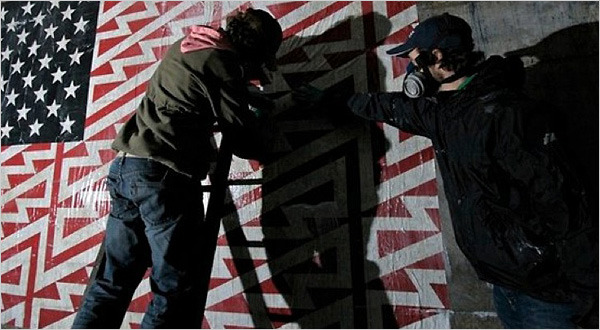The "rape" of yoga and the problem of invented traditions
 Tuesday, March 1, 2011 at 05:35PM
Tuesday, March 1, 2011 at 05:35PM While the Tea Party continues to press its advantage in yet another round of the interminable American culture wars, a far more interesting cultural battleground is brewing in the Indian community over the question: who owns yoga?
Over the past year or so, a number of Hindu groups in America, in particular the Hindu American Foundation, have been working to remind westerners that that yoga isn't just about stretching and stretch pants, that it is instead part of an unbroken Hindu religious tradition that stretches back 5000 years. The fight has been brewing for a while, but it came to more general attention last November when the New York Times published a piece about the fight entitled "take back yoga". What is striking about that piece is that the Hindu groups seem conflicted, and unable to decide whether what they find objectionable is that their ancient tradition has been commercialized, or that they're not getting a big enough slice of the pie.
This is, of course, a classic dilemma of authenticity. But it isn’t necessarily a contradiction – there’s nothing inherently wrong with insisting that if a culture is going to be sold at a profit, the people who invented that culture should share in the wealth. But it gets a bit more complicated when what is being laid claim to is an invented tradition. In the classic definition from Eric Hobsbawm, an invented tradition is "a set of practices, normally governed by overtly or tacitly accepted rules and of a ritual or symbolic nature, which seek to inculcate certain values and norms of behaviour by repetition, which automatically implies continuity with the past."
The point of an invented tradition is that it is not about the past, it is about the present. For Hobsbawm, many traditions are invented by national elites to justify the existence and importance of their respective nation states – such as the whole-cloth invention of the Turkish nation by Ataturk. A recent example was the use of the Loya Jirga to cement Hamid Karzai as the legitimate president of Afghanistan, by (falsely) implying that this is how Afghan rulers had been chosen for centuries.
But sometimes the point of an invented tradition is about laying a claim of cultural identity, intellectual primacy, economic ownership, and even of the moral high ground. The fight over who owns yoga involves all of these. And if a recent article by Meera Nanda for Open Magazine is correct, yoga – as understood by all the players in this fight – is an invented tradition.
I won’t try to summarize the entire article – you should really just pause here and go read it for yourself before I continue – but here is the money claim: The HAF argument - that all yoga, especially its physical or hatha yoga component, is rooted in the Hindu way of life that goes all the way back to the Vedic sages and yogis – is false. Instead,
what HAF calls the “rape of yoga”, referring to the separation of asanas from their spiritual underpinning, did not start in the supposedly decadent West; it began, in fact, in the akharas and gymnasiums of 19th and 20th century India run by Indian nationalists seeking to counter Western images of effete Indians. It is in this nationalistic phase that hatha yoga took on many elements of Western gymnastics and body-building, which show up in the world-renowned Iyengar and Ashtanga Vinyasa schools of yoga. Far from honestly acknowledging the Western contributions to modern yoga, we Indians simply brand all yoga as ‘Vedic,’ a smug claim that has no intellectual integrity.
The argument then is that 21st century yoga not an integral part of an ancient and pristine cultural and spiritual tradition. Instead, it is a mongrel, a thoroughly modern and cosmopolitan practice upon which Hinduism “has no special claims.” If this is true, then it causes a few problems for the “take back yoga” movement. Most obviously, it undercuts any claims that there is a “yoga” that was stolen or appropriated from Hindus and which is there to be reclaimed. It also undercuts any possible financial claims that might be made, and puts a crimp in the mat of any lawsuits over yoga postures and intellectual property rights.
But it also causes problems for westerners. After all, a great deal of the appeal of yoga to North Americans, apart from how great they look in Lululemon clothes, has been precisely that it is an integral part of an ancient, pristine, and highly exotic cultural tradition. After all, there are plenty of more explicitly “western” practices that offer pretty much the same physical benefits as yoga – Pilates being the prime example – but which have not had nearly the cultural and economic impact. As Meera Nanda puts it,
Thus, doing namastes, intoning ‘om’ and chanting Sanskrit mantras have become a part of the experience of doing yoga in America. Many yoga studios use Indian classical or kirtan music, incense, signs of ‘om’ and other paraphernalia of the Subcontinent to create a suitably spiritual ambience.
More than any other factor, yoga owes its success in North America to the fact that it serves the needs of hip, young, urban, white, people whose lives lack nothing except a sense of authenticity. Unable to find it in their own seemingly deprived traditions, these authenticity seekers do what they’ve always done – look for it in the exotic, the ancient, the un-marketed.
There is an excellent film called "Yoga, Inc.", which addresses the question of whether "yoga can survive big business with its karma intact". I suspect the answer to that is “yes”. The bigger question is whether yoga can surive the revelation that its karma owes more to turn-of-the-20th-century Danish gymnasts than to ancient forest-dwelling Brahmin sages.
 authenticity,
authenticity,  hinduism,
hinduism,  karma,
karma,  meera nanda,
meera nanda,  open magazine,
open magazine,  yoga
yoga 


